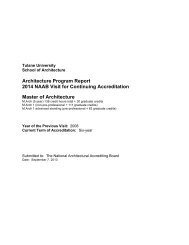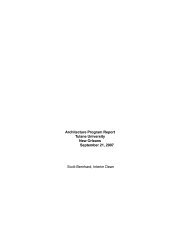NAAB Conditions for Accreditation, 2009 - Tulane School of ...
NAAB Conditions for Accreditation, 2009 - Tulane School of ...
NAAB Conditions for Accreditation, 2009 - Tulane School of ...
Create successful ePaper yourself
Turn your PDF publications into a flip-book with our unique Google optimized e-Paper software.
<strong>2009</strong> <strong>Conditions</strong> <strong>for</strong> <strong>Accreditation</strong><br />
National Architectural Accrediting Board, Inc.<br />
Realm B: Integrated Building Practices, Technical Skills and Knowledge: Architects<br />
are called upon to comprehend the technical aspects <strong>of</strong> design, systems and materials,<br />
and be able to apply that comprehension to their services. Additionally they must<br />
appreciate their role in the implementation <strong>of</strong> design decisions, and the impact <strong>of</strong> such<br />
decisions on the environment. Students learning aspirations include:<br />
Creating building designs with well-integrated systems.<br />
Comprehending constructability.<br />
Incorporating life safety systems.<br />
Integrating accessibility.<br />
Applying principles <strong>of</strong> sustainable design.<br />
B. 1. Pre-Design: Ability to prepare a comprehensive program <strong>for</strong> an architectural<br />
project, such as preparing an assessment <strong>of</strong> client and user needs, an<br />
inventory <strong>of</strong> space and equipment requirements, an analysis <strong>of</strong> site<br />
conditions (including existing buildings), a review <strong>of</strong> the relevant laws and<br />
standards and assessment <strong>of</strong> their implications <strong>for</strong> the project, and a<br />
definition <strong>of</strong> site selection and design assessment criteria.<br />
B. 2. Accessibility: Ability to design sites, facilities, and systems to provide<br />
independent and integrated use by individuals with physical (including<br />
mobility), sensory, and cognitive disabilities.<br />
B. 3. Sustainability: Ability to design projects that optimize, conserve, or reuse<br />
natural and built resources, provide healthful environments <strong>for</strong><br />
occupants/users, and reduce the environmental impacts <strong>of</strong> building<br />
construction and operations on future generations through means such as<br />
carbon-neutral design, bioclimatic design, and energy efficiency.<br />
B. 4. Site Design: Ability to respond to site characteristics such as soil,<br />
topography, vegetation, and watershed in the development <strong>of</strong> a project<br />
design.<br />
B. 5. Life Safety: Ability to apply the basic principles <strong>of</strong> life-safety systems with an<br />
emphasis on egress.<br />
B. 6. Comprehensive Design: Ability to produce a comprehensive architectural<br />
project that demonstrates each student’s capacity to make design decisions<br />
across scales while integrating the following SPC:<br />
A.2. Design Thinking<br />
Skills<br />
B.2. Accessibility<br />
A.4. Technical<br />
B.3. Sustainability<br />
Documentation<br />
B.4. Site Design<br />
A.5. Investigative Skills<br />
B.5. Life Safety<br />
A.8. Ordering Systems<br />
B.8. Environmental Systems<br />
A.9. Historical Traditions<br />
and Global Culture<br />
B.9. Structural Systems<br />
23














